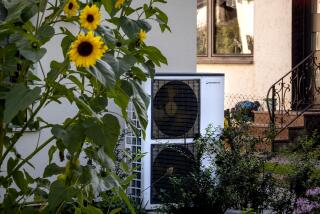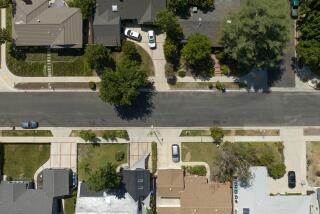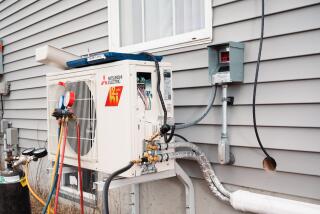Splish splash for less cash
- Share via
For Southern Californians trying to save water and reduce their use of energy, a pool may seem like the biggest unnecessary luxury around.
But with about 500,000 pools in Los Angeles, Orange and Ventura counties combined -- the largest concentration of pools in North America, according to research firm Pool List USA -- pool culture is ingrained in the region. One change: Much of the industry, including designers, builders and suppliers, is reinventing itself and moving toward more sustainable ways of building and maintaining these water worlds.
“A typical lawn uses more water than a swimming pool, but in today’s market, people are looking for responsible luxury,” says Tim Honadel, co-owner of Pools by Ben, a Santa Clarita firm specializing in pool upgrades and energy-efficient systems.
California Energy Commission regulations require equipment to use less energy than in decades past, especially in new pools. And homeowners continue to find ways of enhancing their backyards with new pools or updating old pools with a contemporary look or modern technology.
Here are four steps you can take to improve the energy efficiency of your pool, whether you’re building or renovating.
1. Resurface it.
Vintage plaster pools degrade over time, requiring patching and other repairs. If clients are giving an old pool a face-lift, Los Angeles interior designer Lory Johansson Pools by Ben I UNTAGGED--THIS URL IS AVAILABLE FOR PURCHASE, ACCORDING TO GO DADDY; LOOKS LIKE SHE’S NOW PART OF A COMPANY CALLED ERGO DESIGN WORKS: https://www.ergodesignworks.com/people_lory.htm -BH//Yes, thanks. www.loryjohansson.com “> www.loryjohansson.com was supposed to go live earlier this week but obviously has not; let’s put no URL, and when the site does go live, I can add a hyperlink. Thanks.// encourages clients to make more substantial changes so the pool is more sustainable.
By reducing the depth, you can shrink the volume of water required to fill it.
“Those of us who grew up in the Valley are used to 8-foot-deep diving pools, but people don’t really use them that way anymore,” Johansson says. “The cool thing about making a pool shallower is that you’ll use less water, which also means you’ll use less energy to heat it.”
Johansson also likes black, navy or dark green finishes. “When you make the pool bottom dark, it helps heat the pool faster,” she says. “Plus, I think it has a softer look in the landscape.”
Some dark pool finishes get a bad rap because they can streak or discolor. Johansson recommends Colorquartz, a 3M product that is added to plaster.
“It has little glass beads, as find as sand,” she says. “The average person wouldn’t know what it is, but it homogenizes the color of the plaster.”
David Penton, owner of Fluid Dynamics Pool and Spa in Fullerton, prefers a product called Pebble Tec for uniform color that won’t fade. The finely textured aggregate is applied like standard plaster, then washed to expose the pebble surface.
“It’s not perfectly smooth, but there are different gradations,” some of which can be sanded to be softer, Penton says.
--
2. Change the pump.
Due partly to new California energy standards, some of which went into effect in 2006 and others that roll out Jan. 1, the pool industry is moving toward more energy-efficient pumps, motors, heaters and filtration systems. The Assn. of Pool & Spa Professionals’ energy-efficiency committee is drafting a national standard to emulate California’s new codes, according to committee chairman Steve Barnes, safety and compliance manager for Pentair Water Pool and Spa in Moorpark. Plans also include a pool scoring system modeled after the Energy Star program used with home appliances.
The changes reflect consumer preferences, Barnes says.
“Smart, forward-thinking builders realize that when customers can cut their electricity bill, they’ll use the savings to upgrade on pool tile or add a waterfall or fancy decking,” he says. “People are taking energy savings and building a nicer pool.”
Products that meet the new standards include variable-speed pumps, which have an on-demand feature. Barnes likens the pumps to cars driven at lower speeds, so they get more miles per gallon.
“A variable speed pump has the biggest potential for saving on a typical pool,” he says. Homeowners can expect to save 75% on their power bills, he says.
Pentair’s IntelliFlo pump begins at $1,400 installed, but the system pays for itself in 12 to 18 months, Barnes says. Pool owners can use the company’s online Pool Pump Cost Savings Calculator at www.pentairpool.com to compare their current pump with an energy-efficient one. Southern California Edison’s Home Energy Efficiency Rebate Program gives rebates up to $200 to customers who switch to an energy efficient pump. Check www.sce.com (search for “pool pump and motor rebate”) for details.
--
3. Change the lighting.
Another way to shrink your pool’s energy usage is to switch to LEDs, Barnes says.
“You can replace a 500-watt underwater pool light with an LED fixture and get the same amount of light with a 60-watt bulb,” he says.
Upgrading an existing light requires an investment; LEDs cost $300 to $400 more than a traditional fixture. But if you’re building a new pool, it’s a good time to specify LEDs. The lamp life on an LED light is as long as 10,000 hours, another reason to make the switch, Barnes says.
--
4. Cover it.
A pool cover can slow or even stop evaporation, contractor Penton says. Solar blankets are relatively inexpensive ($150 to $200 for a large residential pool). Though they have been around for a long time, many people don’t use them because “they are a bit of a hassle,” he concedes.
Now, some municipalities are requiring new pools to have a solar blanket, which looks like thick bubble wrap and can be trimmed to fit snugly.
“In Yorba Linda, for example, the city won’t sign off on a final inspection unless we have a solar blanket on site,” Penton says.
The plastic layer reduces water loss because most evaporation is caused by the wind blowing across the pool’s surface. It also helps to retain heat when the pool isn’t in use, he says.
“It’s an affordable way to capture a bunch of savings,” Penton says. “You’ll probably increase your water temperature by 4 to 5 degrees in the middle of summer.”
--
More to Read
Sign up for The Wild
We’ll help you find the best places to hike, bike and run, as well as the perfect silent spots for meditation and yoga.
You may occasionally receive promotional content from the Los Angeles Times.






